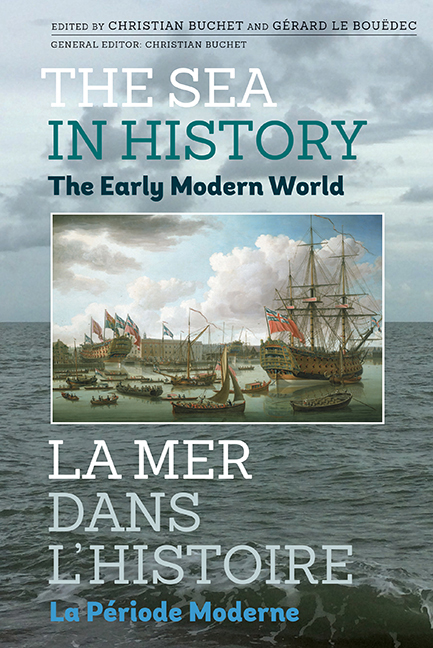Book contents
- Frontmatter
- Contents
- List of Illustrations
- List of Contributors
- Introduction générale et remerciements par
- General introduction and acknowledgements
- Introduction (français)
- Introduction (English)
- LA RÉUSSITE PAR LA MER:La reussite par la mer des territoires et des communautés littorales
- La construction d'un espace mondial: La circulation maritime et les ports
- La forte croissance de l'économie des pêches et des échanges
- Les acteurs de la dynamique maritime
- LA PUISSANCE MARITIME INSTRUMENT DE LA PUISSANCE POLITIQUE ET D'UNE STRATÉGIE GLOBALE DE RAYONNEMENT VOIRE DE DOMINATION: Les puissances maritimes occidentales
- L'océan Indien, entre convoitises et indifférences
- Les puissances maritimes asiatiques
- L'Afrique
- L'Afrique et la mer à l'époque moderne
- La mer et les royaumes du golfe de Guinée
- Maratha sea power
- La politique maritime et l'idéologie
- Mer et développement technologique
- Développement maritime et maîtrise économique et financière
- Développement maritime et maîtrise organisationnelle
- Conclusion (français)
- Conclusion (English)
- Conclusion générale par
- General conclusion by
- Miscellaneous Endmatter
- Miscellaneous Endmatter
Maratha sea power
from L'Afrique
Published online by Cambridge University Press: 11 May 2017
- Frontmatter
- Contents
- List of Illustrations
- List of Contributors
- Introduction générale et remerciements par
- General introduction and acknowledgements
- Introduction (français)
- Introduction (English)
- LA RÉUSSITE PAR LA MER:La reussite par la mer des territoires et des communautés littorales
- La construction d'un espace mondial: La circulation maritime et les ports
- La forte croissance de l'économie des pêches et des échanges
- Les acteurs de la dynamique maritime
- LA PUISSANCE MARITIME INSTRUMENT DE LA PUISSANCE POLITIQUE ET D'UNE STRATÉGIE GLOBALE DE RAYONNEMENT VOIRE DE DOMINATION: Les puissances maritimes occidentales
- L'océan Indien, entre convoitises et indifférences
- Les puissances maritimes asiatiques
- L'Afrique
- L'Afrique et la mer à l'époque moderne
- La mer et les royaumes du golfe de Guinée
- Maratha sea power
- La politique maritime et l'idéologie
- Mer et développement technologique
- Développement maritime et maîtrise économique et financière
- Développement maritime et maîtrise organisationnelle
- Conclusion (français)
- Conclusion (English)
- Conclusion générale par
- General conclusion by
- Miscellaneous Endmatter
- Miscellaneous Endmatter
Summary
ABSTRACT. The construction of a navy completely modified the history of the Indian kingdom of Maratha over 60 years. This maritime development prompted economic and commercial growth, which subsequently interacted with each other. It gave the small kingdom unprecedented influence and prevented European navies from reaping economic advantages.
RÉSUMÉ. L'édification d'une marine a totalement modifié la trajectoire historique du royaume indien de Maratha sur 60 ans. Cette édification a induit une croissance économique et commerciale qui se sont mis en interaction. Ce développement maritime a eu pour effet un rayonnement sans précédent pour ce petit royaume et a empêché les marines européennes de bénéficier de ces retombées économiques.
India has been known to have overseas trading relations with distant lands as far as Rome and with ports in the Persian Gulf, the Red Sea, and the East African coast. Indian ships were bigger, reaching 1500-ton brethren. Indian seamen were skilled sailors and had great knowledge in winds, tides, stellar navigation, etc. India had a rich maritime tradition but nowhere in Indian history was there a mention of developing a navy for defensive purpose. Though there are incidents of Indian rulers having overseas naval expedition and establishing their kingdom. By the Middle Ages the Indian trade was dominated by the Gujarati and Arabs traders. The Portuguese entered Indian water with Vasco da Gama reaching Calicut in 1498. The route to India also resulted in frenzy of activities from England, the United Provinces and France to reach India to be a part of a lucrative trade. They sought permissions from local rulers and began to dominate the Indian trade with force whenever necessary or not. The Portuguese in particular dominated the sea trade by sheer use of superior naval force and naval artillery.
The 15th century was also the time when northern India was under control of the Mughals, and southern India was divided into smaller Muslim kingdoms such as Bijapur, Hyderabad and Golconda. The general orientation of Indian rulers was towards land and hence never had envisaged the need for protecting their sea frontier. This was due to the fact that such need never arose and hence they never paid any attention to establish a naval organization.
- Type
- Chapter
- Information
- The Sea in History - The Early Modern World , pp. 635 - 648Publisher: Boydell & BrewerPrint publication year: 2017



